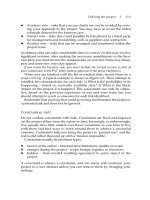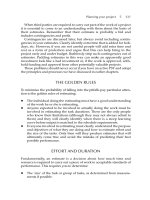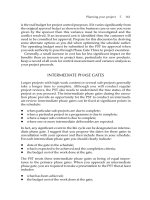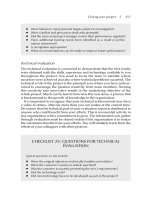Management a practical introduction 3rd kinicky chapter 13
Bạn đang xem bản rút gọn của tài liệu. Xem và tải ngay bản đầy đủ của tài liệu tại đây (203.43 KB, 36 trang )
Management
A Practical Introduction
Third Edition
Angelo Kinicki &
Brian K. Williams
Kinicki/Williams, Management: A Practical Introduction 3e ©2008, McGraw-Hill/Irwin
Manager’s Toolbox
Dealing With Disagreements
Avoiding—maybe the problem will go away
Accommodating—let’s do it your way
Forcing—you have to do it my way
Compromising—let’s split the difference
Collaborating—let’s cooperate to reach a win-win solution that
benefits both of us
Strength: its longer lasting effect – deals with the underlying
problem, not just symptoms
Weakness: time consuming
McGraw-Hill/Irwin
Kinicki/Williams, Management: A Practical Introduction 3e ©2008, McGraw-Hill/Irwin
© 2006 The McGraw-Hill Companies, Inc. All rights rese
2
Chapter 13: Groups & Teams
Increasing Cooperation,
Reducing Conflict
Groups versus Teams
Groups & Team Development
Building Effective Teams
Managing Conflict
Kinicki/Williams, Management: A Practical Introduction 3e ©2008, McGraw-Hill/Irwin
3
13.1 Groups Versus Teams
WHY IS TEAMWORK IMPORTANT?
Peter Drucker argues that tomorrow’s
organizations will be flatter, information- based, and
organized around teams
Teams offer increased productivity, increased
speed, reduced costs, improved quality, reduced
destructive internal competition, and improved
workplace cohesiveness
Kinicki/Williams, Management: A Practical Introduction 3e ©2008, McGraw-Hill/Irwin
4
Groups & Teams: How Do They Differ?
Group: two or more
freely interacting
individuals who share
collective norms, share
collective goals,, and have
a common identity –
performing as individuals
Management-Directed
McGraw-Hill/Irwin
Team: small group of
people with
complementary skills
who are committed to a
common purpose,
performance goals,
and approach, or which
they hold themselves
mutually accountable –
essence is common
commitment
Self-Directed
Kinicki/Williams, Management: A Practical Introduction 3e ©2008, McGraw-Hill/Irwin
© 2006 The McGraw-Hill Companies, Inc. All rights rese
5
Formal versus Informal Groups
Formal Group –
created to do productive
work
is a group
established to do
something
productive for the
organization and is
headed by a leader.
McGraw-Hill/Irwin
Informal Group –
created for friendship
is a group formed by
people seeking
friendship and has
no officially
appointed leader,
although a leader
may emerge from
the membership.
Kinicki/Williams, Management: A Practical Introduction 3e ©2008, McGraw-Hill/Irwin
© 2006 The McGraw-Hill Companies, Inc. All rights rese
6
Various Types of Teams
Crossfunctional
teams
Members composed of people from different departments such as
sales and production, pursuing a common objective
Problemsolving
teams
Knowledgeable workers
meet as a temporary team to solve a
5.who
Selfspecific problem, then
disband
actualization
Quality
Circle
Volunteers of workers and supervisors who meet intermittently to
discuss workplace and quality-related problems
Selfmanaged
team
Workers are trained to do all or part of the jobs in a work unit, have
no direct supervisor, and do their own day-to-day supervision
Topmanagement
team
Members consists of the CEO, president, and top department
heads and work to help organization achieve its mission and goals
Virtual team
Members interact by computer network to collaborate on projects
Work team
Members engage in collective work requiring coordinated effort;
purpose of team is advice, production, problem, or action
McGraw-Hill/Irwin
needs
Kinicki/Williams, Management: A Practical Introduction 3e ©2008, McGraw-Hill/Irwin
© 2006 The McGraw-Hill Companies, Inc. All rights rese
7
Four Purposes of Work Teams
1)
Advice Teams – broaden the information base for
managerial decisions
2)
Committees, advisory councils, and quality circles
Production Teams – responsible for performing day-today operations
McGraw-Hill/Irwin
Maintenance crews, assembly teams, and mining teams
Kinicki/Williams, Management: A Practical Introduction 3e ©2008, McGraw-Hill/Irwin
© 2006 The McGraw-Hill Companies, Inc. All rights rese
8
Four Purposes of Work Teams
3)
Project Teams – work to do creative problem solving
1)
2)
4)
A Cross Functional Team is staffed by specialists pursuing a
common objective
Research groups, development teams, and task forces
Action Teams – work to accomplish tasks that require
people with
1)
McGraw-Hill/Irwin
(1) specialized training, and
(2) a high degree of coordination
Hospital surgery teams, police SWAT teams, and labor
contract negotiating teams, baseball teams
Kinicki/Williams, Management: A Practical Introduction 3e ©2008, McGraw-Hill/Irwin
© 2006 The McGraw-Hill Companies, Inc. All rights rese
9
13.1 Groups Versus Teams
Self-managed teams are groups of workers who
are given administrative oversight for their task
domains
These teams have emerged out of quality circles
(small groups of volunteers or workers or supervisors
who meet intermittently to discuss workplace and
quality issues)
The goal of self-managed teams is to increase
productivity and employee quality of work life
Kinicki/Williams, Management: A Practical Introduction 3e ©2008, McGraw-Hill/Irwin
10
Quality Circles & Self-Managed Teams
Quality Circles:
consists of small groups
of volunteers of workers
and supervisors who
meet intermittently to
discuss workplace and
quality-related
problems.
McGraw-Hill/Irwin
Self-Managed Teams:
groups of workers who
are given administrative
oversight for their task
domains.
Needs extensive training
on how to be team players
The goal of self-managed
teams is to increase
productivity and employee
quality of work life
Kinicki/Williams, Management: A Practical Introduction 3e ©2008, McGraw-Hill/Irwin
© 2006 The McGraw-Hill Companies, Inc. All rights rese
11
13.2 Stages of Group & Team Involvement
Figure 13.1: Five Stages of Group and Team Development
Kinicki/Williams, Management: A Practical Introduction 3e ©2008, McGraw-Hill/Irwin
12
13.2 Stages of Group & Team Involvement
HOW DOES A GROUP EVOLVE INTO A TEAM?
Groups evolve into teams by going through five stages:
Stage 1: Forming – Why are we here?
the process of getting oriented and getting acquainted
This stage is an uncertain one as members get to know
each other, identify the group’s goals, and determine who is in
charge
Mutual trust is low at this stage
Leaders should let people get acquainted and socialize
during this stage
Kinicki/Williams, Management: A Practical Introduction 3e ©2008, McGraw-Hill/Irwin
13
Five Stages of Group Development
1) Forming – Why are we here?
1) Process of getting oriented and getting
acquainted
2) High degree of uncertainty: who is in charge
and what goals are
3) Leaders should give people time to become
acquainted and socialize
McGraw-Hill/Irwin
Kinicki/Williams, Management: A Practical Introduction 3e ©2008, McGraw-Hill/Irwin
© 2006 The McGraw-Hill Companies, Inc. All rights rese
14
Five Stages of Group Development
2) Storming – Why are we fighting over who
does what and who’s in charge?
1) Characterized by emergence of individual
personalities and roles and conflicts within
the group
2) Length of this stage depends on clarity of
goals and commitment and maturity of
members
3) Individuals may test leader’s policies
McGraw-Hill/Irwin
Kinicki/Williams, Management: A Practical Introduction 3e ©2008, McGraw-Hill/Irwin
© 2006 The McGraw-Hill Companies, Inc. All rights rese
15
Five Stages of Group Development
2) Storming – Why are we fighting over who
does what and who’s in charge?
4) Leader should encourage members to
1) Suggest ideas
2) Voice disagreements
3) Work through their conflicts
McGraw-Hill/Irwin
Kinicki/Williams, Management: A Practical Introduction 3e ©2008, McGraw-Hill/Irwin
© 2006 The McGraw-Hill Companies, Inc. All rights rese
16
Five Stages of Group Development
3) Norming – Can we agree on roles and
work as a team?
1) Conflicts are resolved, close relationships
are developed, and unity and harmony
emerge
2) Group evolves into a team / team spirit
3) Team sets guidelines for what its members
will do to and how they will do it (norms)
4) Authority questions resolved through
unemotional group discussion
McGraw-Hill/Irwin
Kinicki/Williams, Management: A Practical Introduction 3e ©2008, McGraw-Hill/Irwin
© 2006 The McGraw-Hill Companies, Inc. All rights rese
17
Five Stages of Group Development
3) Norming – Can we agree on roles and
work as a team?
5) A “we feeling” binding team members
together is principal by-product
6) Leader should emphasize unity and help
identify team’s goals and values
McGraw-Hill/Irwin
Kinicki/Williams, Management: A Practical Introduction 3e ©2008, McGraw-Hill/Irwin
© 2006 The McGraw-Hill Companies, Inc. All rights rese
18
Five Stages of Group Development
4) Performing – Can we do the job properly?
1) Members concentrate on solving problems
and completing the assigned task
2) Leader should give the empowerment they
need to work on tasks
McGraw-Hill/Irwin
Kinicki/Williams, Management: A Practical Introduction 3e ©2008, McGraw-Hill/Irwin
© 2006 The McGraw-Hill Companies, Inc. All rights rese
19
Five Stages of Group Development
5) Adjourning– Can we help members
transition out?
1) Members prepare for disbandment
2) Rituals celebrating “the end” and “new
beginnings”
3) Leader can highlight valuable lessons learned
to prepare everyone for future team efforts
McGraw-Hill/Irwin
Kinicki/Williams, Management: A Practical Introduction 3e ©2008, McGraw-Hill/Irwin
© 2006 The McGraw-Hill Companies, Inc. All rights rese
20
13.3 Building Effective Teams
HOW CAN YOU BUILD AN EFFECTIVE TEAM?
There are seven keys to building an effective team:
1. Performance Goals & Feedback - teams need specific,
measurable goals and continual feedback
2. Motivation Through Mutual Accountability - mutual
accountability promotes mutual trust and commitment among
team members
3. Size - different sized teams have different characteristics
4. Roles - socially determined expectations of how an
individual should behave in a specific position
Kinicki/Williams, Management: A Practical Introduction 3e ©2008, McGraw-Hill/Irwin
23
Chapter 13: Groups & Teams
CLASSROOM PERFORMANCE SYSTEM
Which of the following is not a characteristic of small
teams?
A) good morale
B) social loafing
C) strong interaction
D) few resources
Kinicki/Williams, Management: A Practical Introduction 3e ©2008, McGraw-Hill/Irwin
24
13.3 Building Effective Teams
Behavior that fosters constructive relationships among team
members is a maintenance role or relationship-oriented role
Behavior that concentrates on getting the team’s task done
is a task role or task oriented role
5. Norms - general guidelines or rules of behavior that most
group or team members follow
Norms tend to be enforced for four reasons:
-to help the group survive
-to clarify role expectation
-to help individuals avoid embarrassing situations
-to emphasize the group’s important values and identity
Kinicki/Williams, Management: A Practical Introduction 3e ©2008, McGraw-Hill/Irwin
25
13.3 Building Effective Teams
6. Cohesiveness - the tendency of a group or team to
stick together
Cohesiveness can be achieved by keeping the
team small, encouraging interaction and cooperation,
emphasizing common characteristics and interests,
identifying environmental threats, and creating a
public image
7. Groupthink - a cohesive group’s blind
unwillingness to consider alternatives
Team members in this situation are friendly and
tight-knit, but are unable to “think outside the box”
Kinicki/Williams, Management: A Practical Introduction 3e ©2008, McGraw-Hill/Irwin
26
Chapter 13: Groups & Teams
CLASSROOM PERFORMANCE SYSTEM
Which of the following does not promote team
cohesiveness?
A) encouraging interaction and cooperation
B) pointing out environmental threats
C) keeping the team relatively large
D) emphasizing member’s common interests
Kinicki/Williams, Management: A Practical Introduction 3e ©2008, McGraw-Hill/Irwin
27









